Understanding Key Principles of the U.S. Constitution: A Presentation
VerifiedAdded on 2022/08/16
|15
|1291
|8
Presentation
AI Summary
This assignment provides a detailed presentation on the core tenets of the U.S. Constitution, including checks and balances, federalism, judicial review, limited government, popular sovereignty, and separation of powers. The presentation aims to educate students or adults for a Constitution Day celebration, with speaker notes expanding on each slide's information. The assignment also includes a 250-500 word essay outlining two interactive learning activities for the intended audience to coincide with the presentation. Additionally, the assignment requires 3 hours of field work, including attending a school board meeting or watching a live stream. The presentation covers the historical context of the Constitution and its importance in the American government.
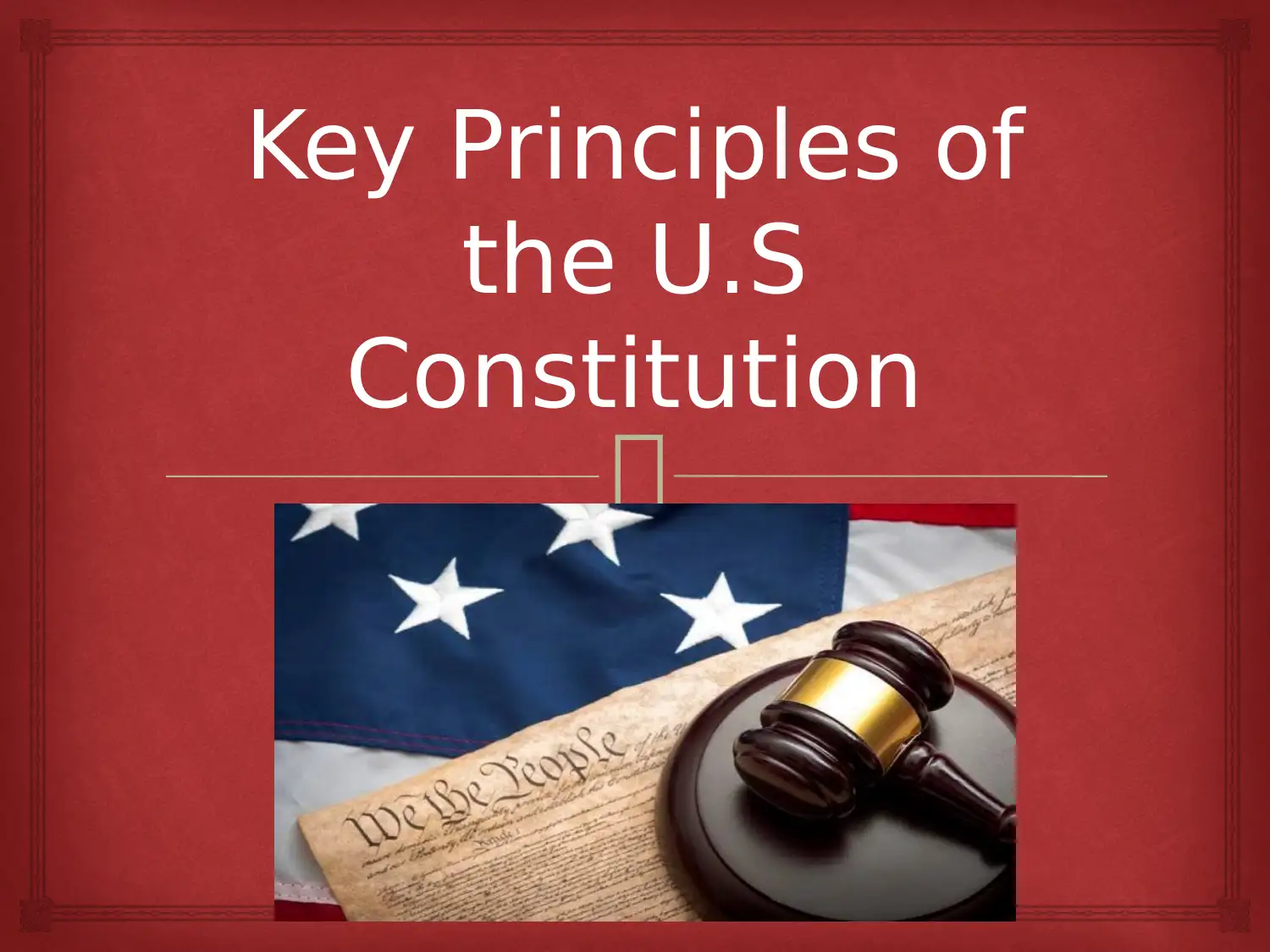
Key Principles of
the U.S
Constitution
Key Principles of
the U.S
Constitution
Paraphrase This Document
Need a fresh take? Get an instant paraphrase of this document with our AI Paraphraser
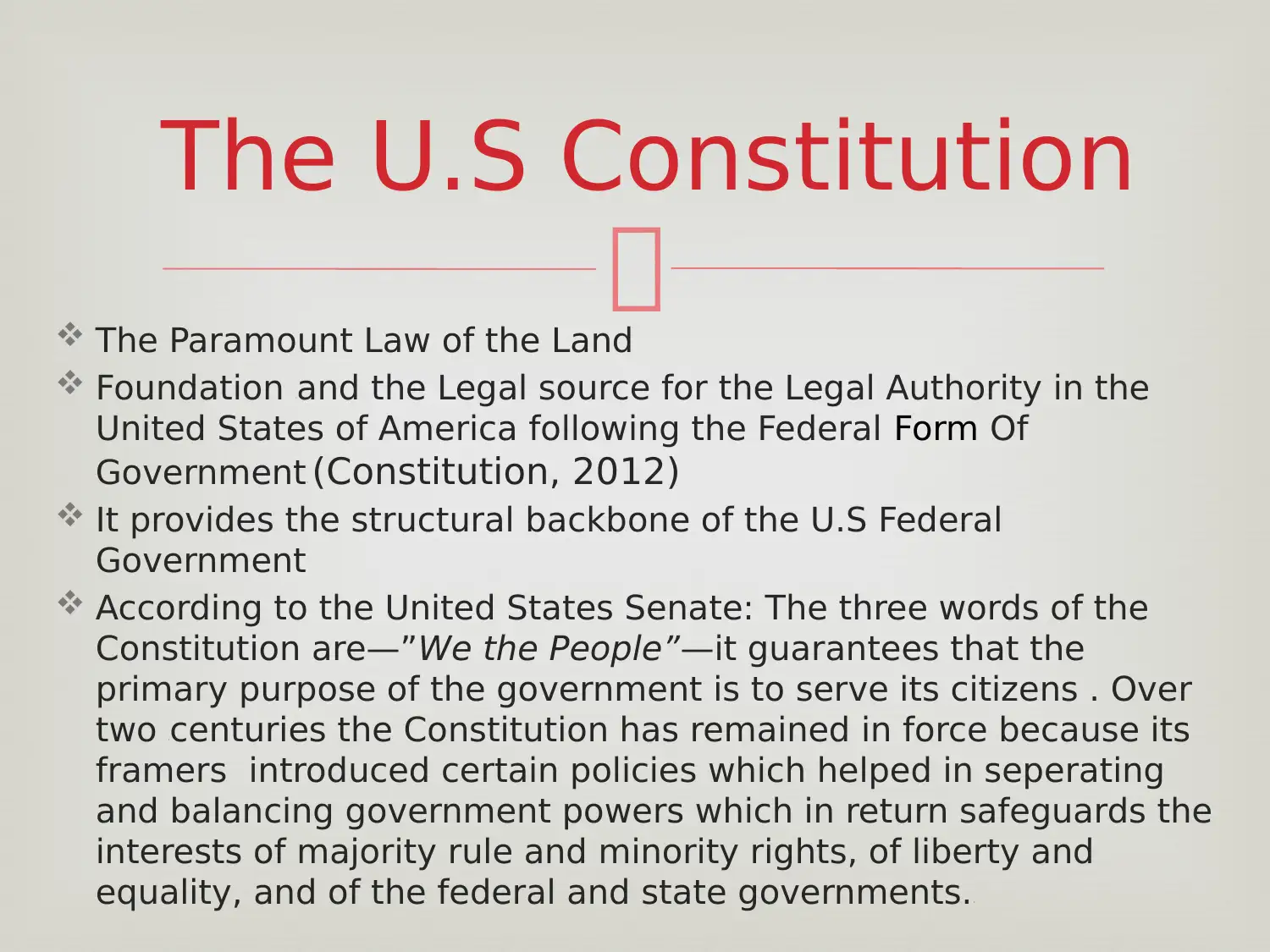
The Paramount Law of the Land
Foundation “and the Legal source for the Legal Authority in the
United States of America following the Federal Form Of
Government” (Constitution, 2012)
It provides the structural backbone of the U.S Federal
Government
According to the United States Senate: The three words of the
Constitution are—”We the People”—it guarantees that the
primary purpose of the government is to serve its citizens . Over
two “centuries the Constitution has remained in force because its
framers introduced certain policies which helped in seperating
and balancing government powers which in return safeguards the
interests of majority rule and minority rights, of liberty and
equality, and of the federal and state governments.”
The U.S Constitution
The Paramount Law of the Land
Foundation “and the Legal source for the Legal Authority in the
United States of America following the Federal Form Of
Government” (Constitution, 2012)
It provides the structural backbone of the U.S Federal
Government
According to the United States Senate: The three words of the
Constitution are—”We the People”—it guarantees that the
primary purpose of the government is to serve its citizens . Over
two “centuries the Constitution has remained in force because its
framers introduced certain policies which helped in seperating
and balancing government powers which in return safeguards the
interests of majority rule and minority rights, of liberty and
equality, and of the federal and state governments.”
The U.S Constitution
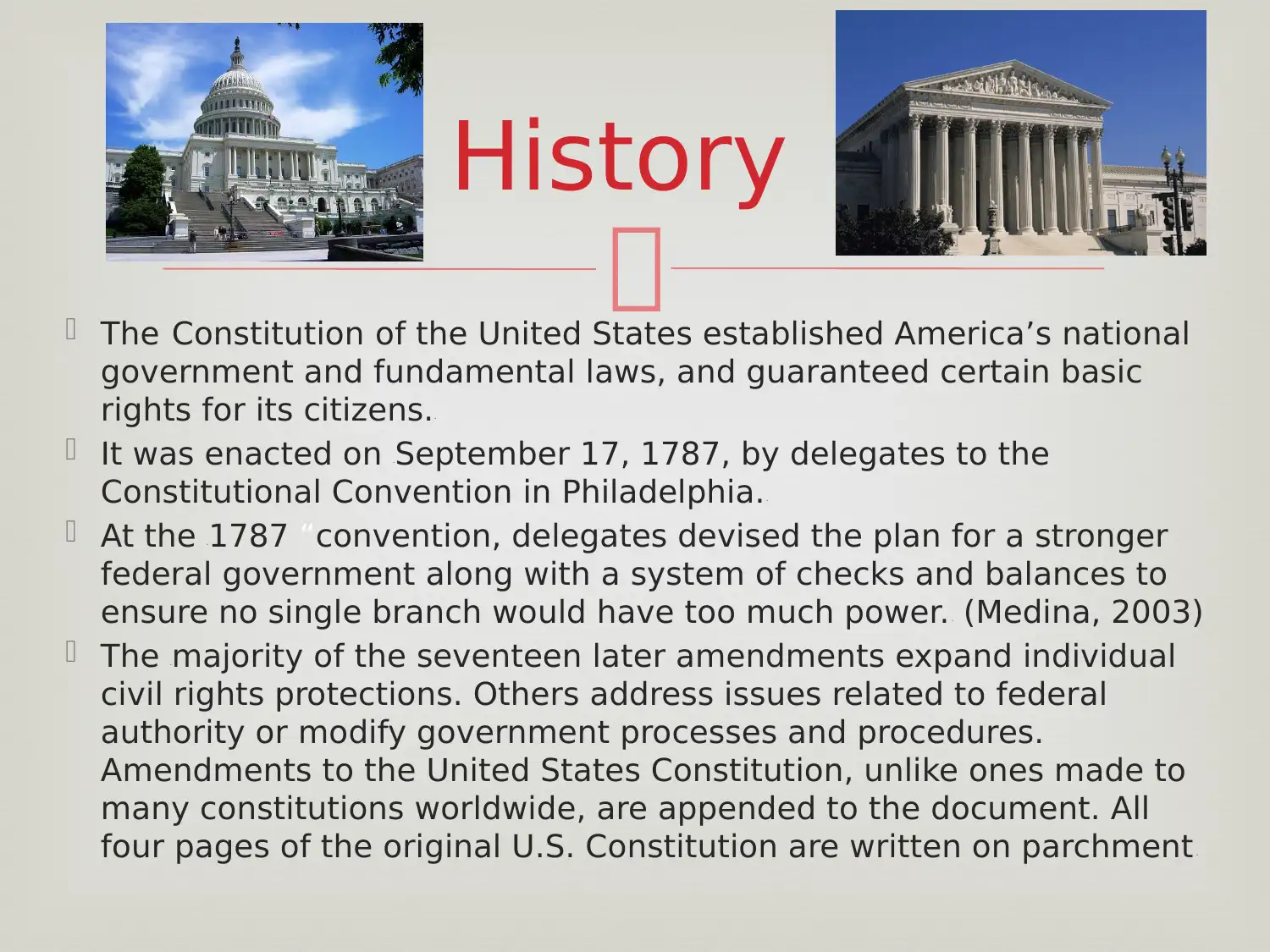
The “Constitution of the United States established America’s national
government and fundamental laws, and guaranteed certain basic
rights for its citizens.”
It was enacted on “September 17, 1787, by delegates to the
Constitutional Convention in Philadelphia.”
At the “1787 “convention, delegates devised the plan for a stronger
federal government along with a system of checks and balances to
ensure no single branch would have too much power.” (Medina, 2003)
The “majority of the seventeen later amendments expand individual
civil rights protections. Others address issues related to federal
authority or modify government processes and procedures.
Amendments to the United States Constitution, unlike ones made to
many constitutions worldwide, are appended to the document. All
four pages of the original U.S. Constitution are written on parchment”
History
government and fundamental laws, and guaranteed certain basic
rights for its citizens.”
It was enacted on “September 17, 1787, by delegates to the
Constitutional Convention in Philadelphia.”
At the “1787 “convention, delegates devised the plan for a stronger
federal government along with a system of checks and balances to
ensure no single branch would have too much power.” (Medina, 2003)
The “majority of the seventeen later amendments expand individual
civil rights protections. Others address issues related to federal
authority or modify government processes and procedures.
Amendments to the United States Constitution, unlike ones made to
many constitutions worldwide, are appended to the document. All
four pages of the original U.S. Constitution are written on parchment”
History
⊘ This is a preview!⊘
Do you want full access?
Subscribe today to unlock all pages.

Trusted by 1+ million students worldwide
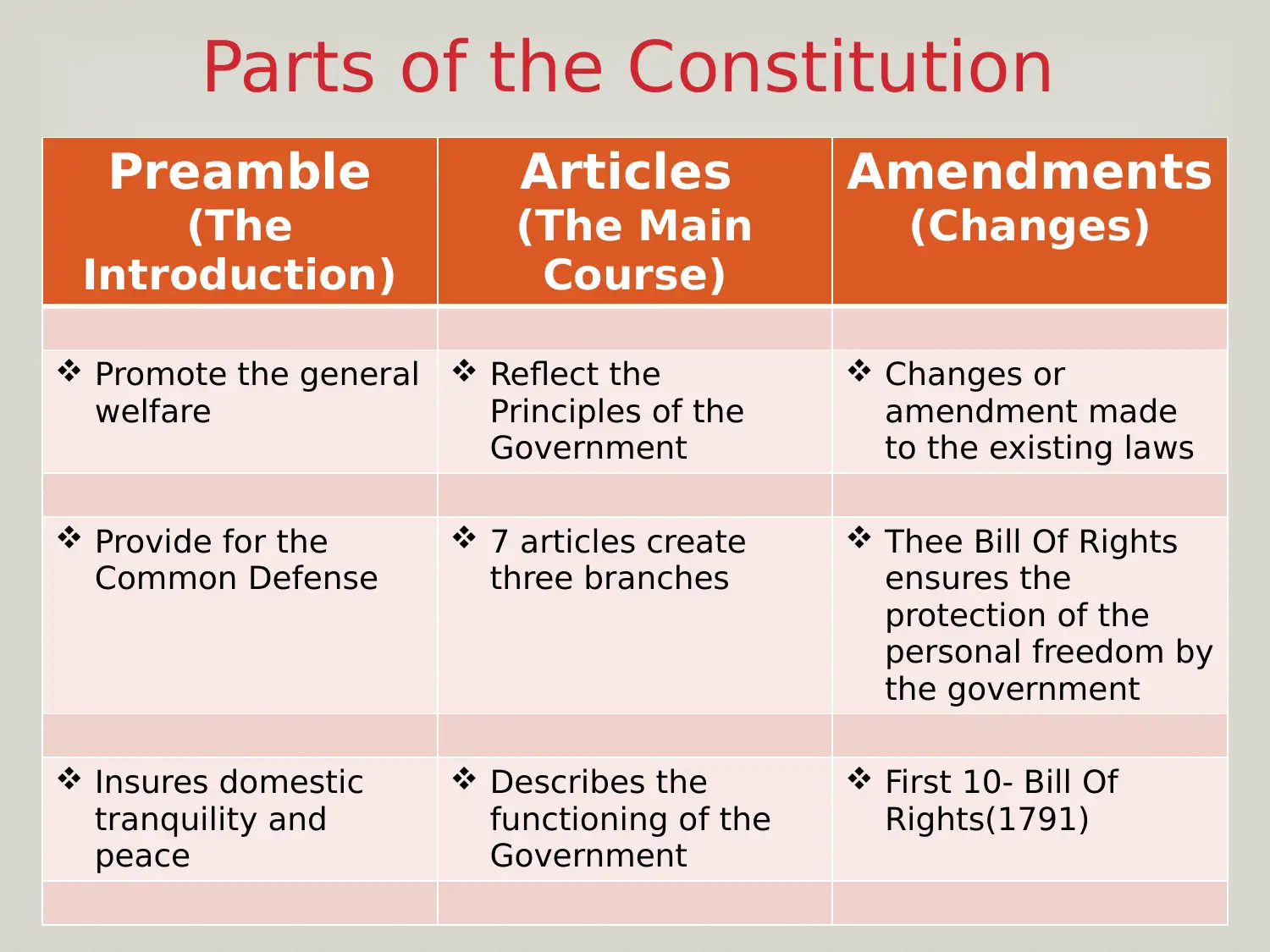
Preamble
(The
Introduction)
Articles
(The Main
Course)
Amendments
(Changes)
Promote the general
welfare
Reflect the
Principles of the
Government
Changes or
amendment made
to the existing laws
Provide for the
Common Defense
7 articles create
three branches
Thee Bill Of Rights
ensures the
protection of the
personal freedom by
the government
Insures domestic
tranquility and
peace
Describes the
functioning of the
Government
First 10- Bill Of
Rights(1791)
Parts of the Constitution
Preamble
(The
Introduction)
Articles
(The Main
Course)
Amendments
(Changes)
Promote the general
welfare
Reflect the
Principles of the
Government
Changes or
amendment made
to the existing laws
Provide for the
Common Defense
7 articles create
three branches
Thee Bill Of Rights
ensures the
protection of the
personal freedom by
the government
Insures domestic
tranquility and
peace
Describes the
functioning of the
Government
First 10- Bill Of
Rights(1791)
Parts of the Constitution
Paraphrase This Document
Need a fresh take? Get an instant paraphrase of this document with our AI Paraphraser
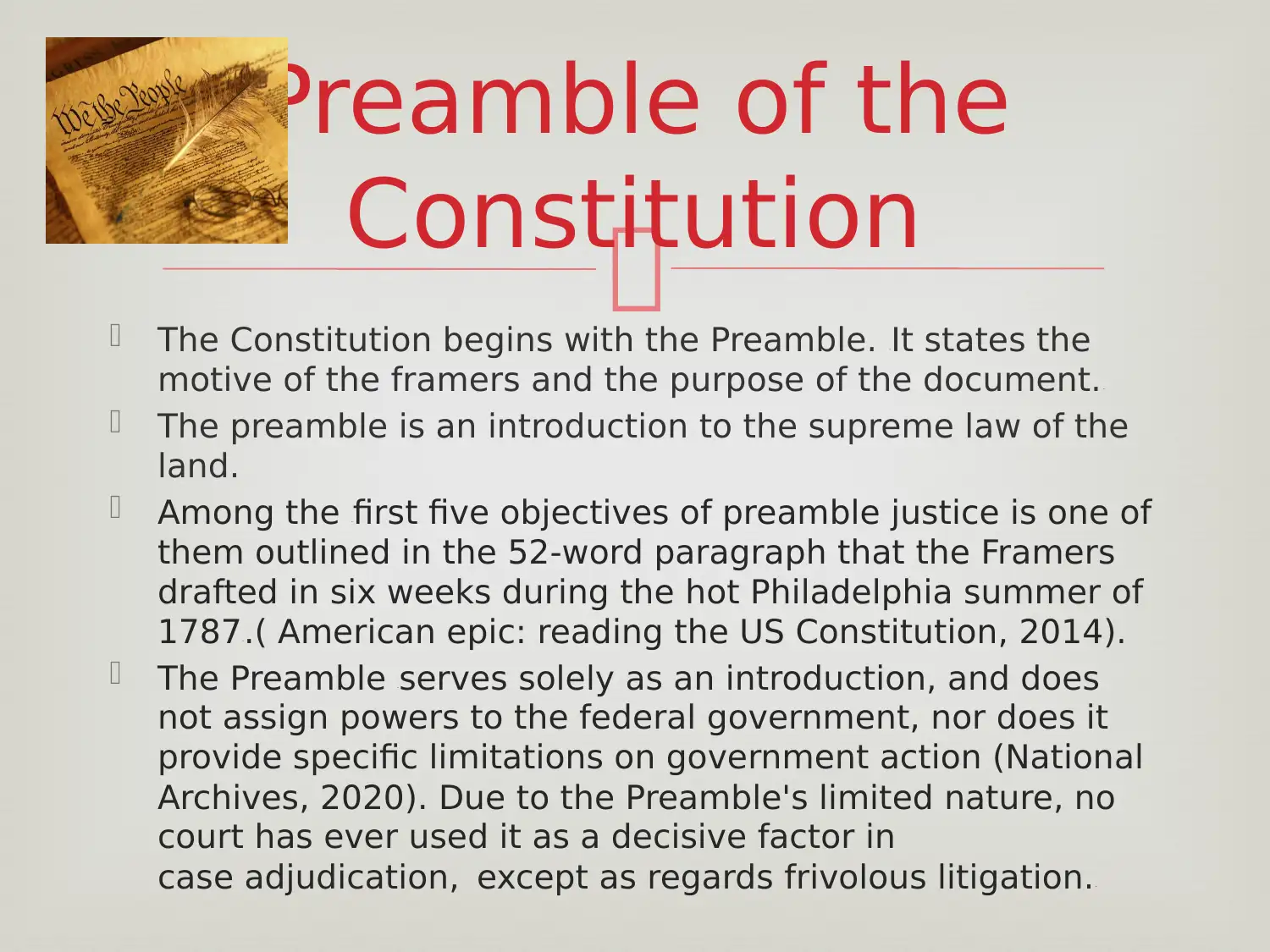
Preamble of the
Constitution
The Constitution begins with the Preamble. “It states the
motive of the framers and the purpose of the document.”
The preamble is an introduction to the supreme law of the
land.
Among the “first five objectives of preamble justice is one of
them outlined in the 52-word paragraph that the Framers
drafted in six weeks during the hot Philadelphia summer of
1787”.( American epic: reading the US Constitution, 2014).
The Preamble “serves solely as an introduction, and does
not assign powers to the federal government, nor does it
provide specific limitations on government action (National
Archives, 2020). Due to the Preamble's limited nature, no
court has ever used it as a decisive factor in
case adjudication, except as regards frivolous litigation.”
Preamble of the
Constitution
The Constitution begins with the Preamble. “It states the
motive of the framers and the purpose of the document.”
The preamble is an introduction to the supreme law of the
land.
Among the “first five objectives of preamble justice is one of
them outlined in the 52-word paragraph that the Framers
drafted in six weeks during the hot Philadelphia summer of
1787”.( American epic: reading the US Constitution, 2014).
The Preamble “serves solely as an introduction, and does
not assign powers to the federal government, nor does it
provide specific limitations on government action (National
Archives, 2020). Due to the Preamble's limited nature, no
court has ever used it as a decisive factor in
case adjudication, except as regards frivolous litigation.”
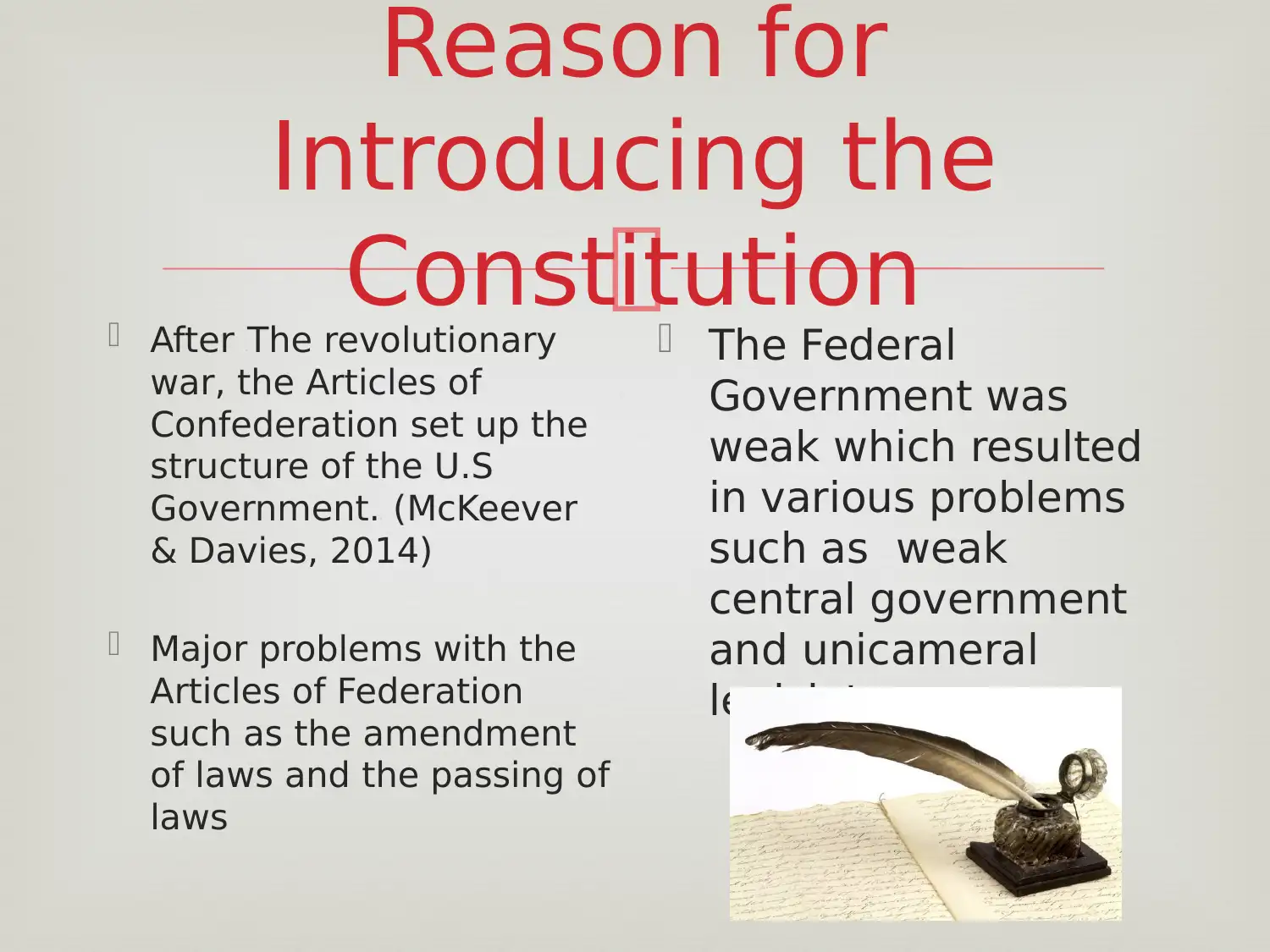
Reason for
Introducing the
Constitution After “The revolutionary
war, the Articles of
Confederation set up the
structure of the U.S
Government.” (McKeever
& Davies, 2014)
Major problems with the
Articles of Federation
such as the amendment
of laws and the passing of
laws
The Federal
Government was
weak which resulted
in various problems
such as weak
central government
and unicameral
legislature
Reason for
Introducing the
Constitution After “The revolutionary
war, the Articles of
Confederation set up the
structure of the U.S
Government.” (McKeever
& Davies, 2014)
Major problems with the
Articles of Federation
such as the amendment
of laws and the passing of
laws
The Federal
Government was
weak which resulted
in various problems
such as weak
central government
and unicameral
legislature
⊘ This is a preview!⊘
Do you want full access?
Subscribe today to unlock all pages.

Trusted by 1+ million students worldwide
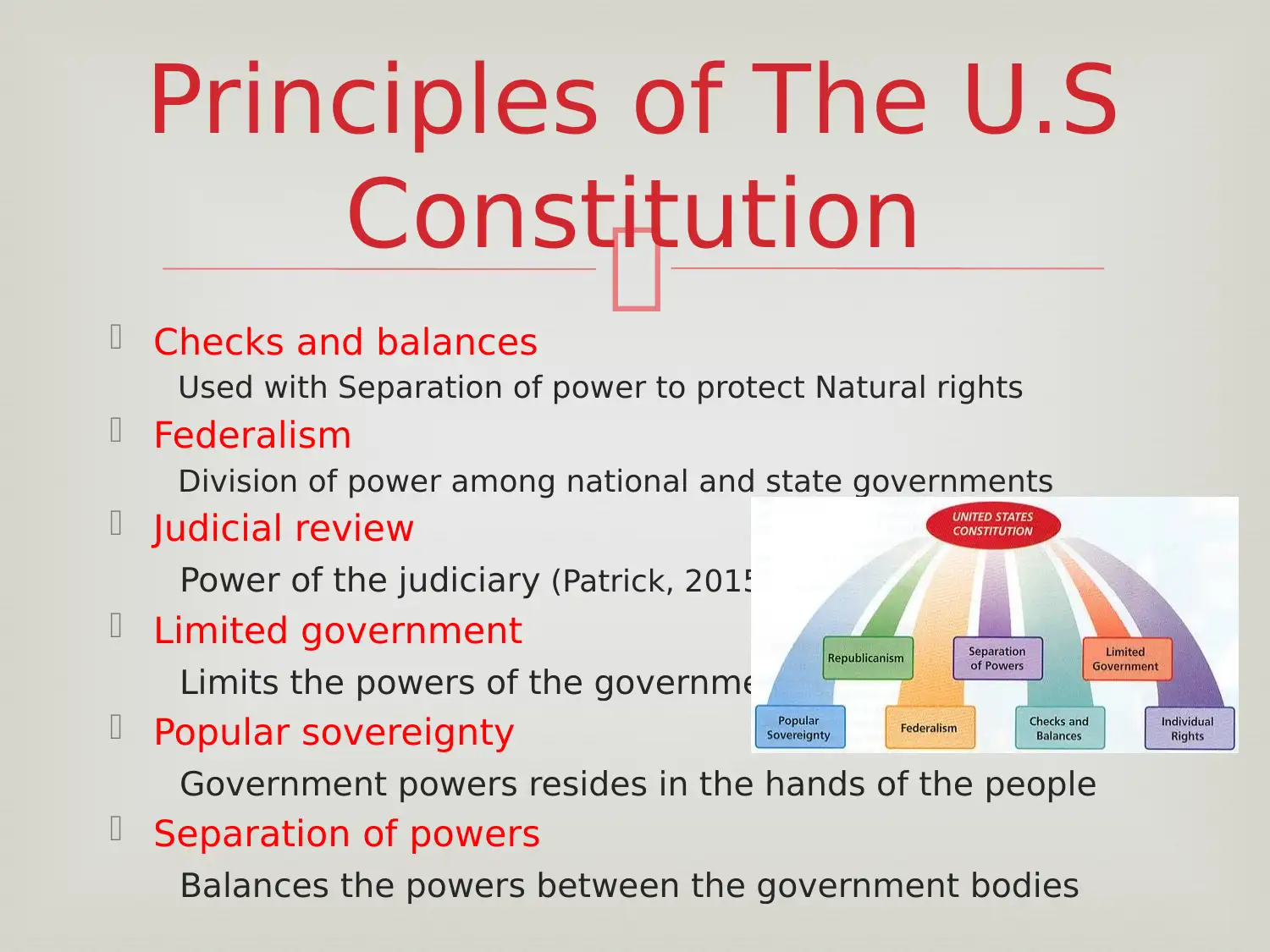
Checks and balances
Used with Separation of power to protect Natural rights
Federalism
Division of power among national and state governments
Judicial review
Power of the judiciary (Patrick, 2015)
Limited government
Limits the powers of the government
Popular sovereignty
Government powers resides in the hands of the people
Separation of powers
Balances the powers between the government bodies
Principles of The U.S
Constitution
Checks and balances
Used with Separation of power to protect Natural rights
Federalism
Division of power among national and state governments
Judicial review
Power of the judiciary (Patrick, 2015)
Limited government
Limits the powers of the government
Popular sovereignty
Government powers resides in the hands of the people
Separation of powers
Balances the powers between the government bodies
Principles of The U.S
Constitution
Paraphrase This Document
Need a fresh take? Get an instant paraphrase of this document with our AI Paraphraser
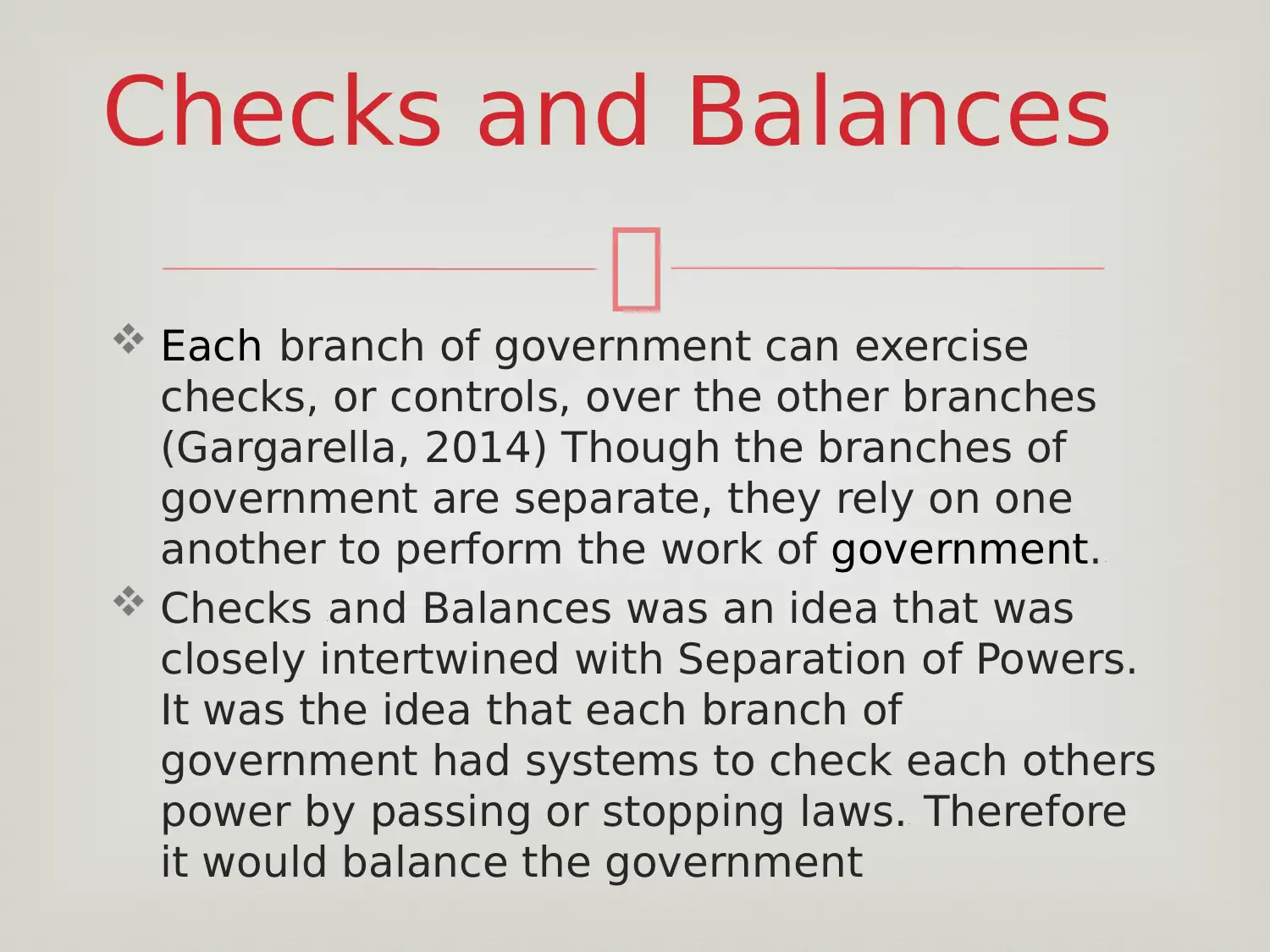
Each “branch of government can exercise
checks, or controls, over the other branches
(Gargarella, 2014) Though the branches of
government are separate, they rely on one
another to perform the work of government.””
Checks “and Balances was an idea that was
closely intertwined with Separation of Powers.
It was the idea that each branch of
government had systems to check each others
power by passing or stopping laws.” Therefore
it would balance the government
Checks and Balances
Each “branch of government can exercise
checks, or controls, over the other branches
(Gargarella, 2014) Though the branches of
government are separate, they rely on one
another to perform the work of government.””
Checks “and Balances was an idea that was
closely intertwined with Separation of Powers.
It was the idea that each branch of
government had systems to check each others
power by passing or stopping laws.” Therefore
it would balance the government
Checks and Balances
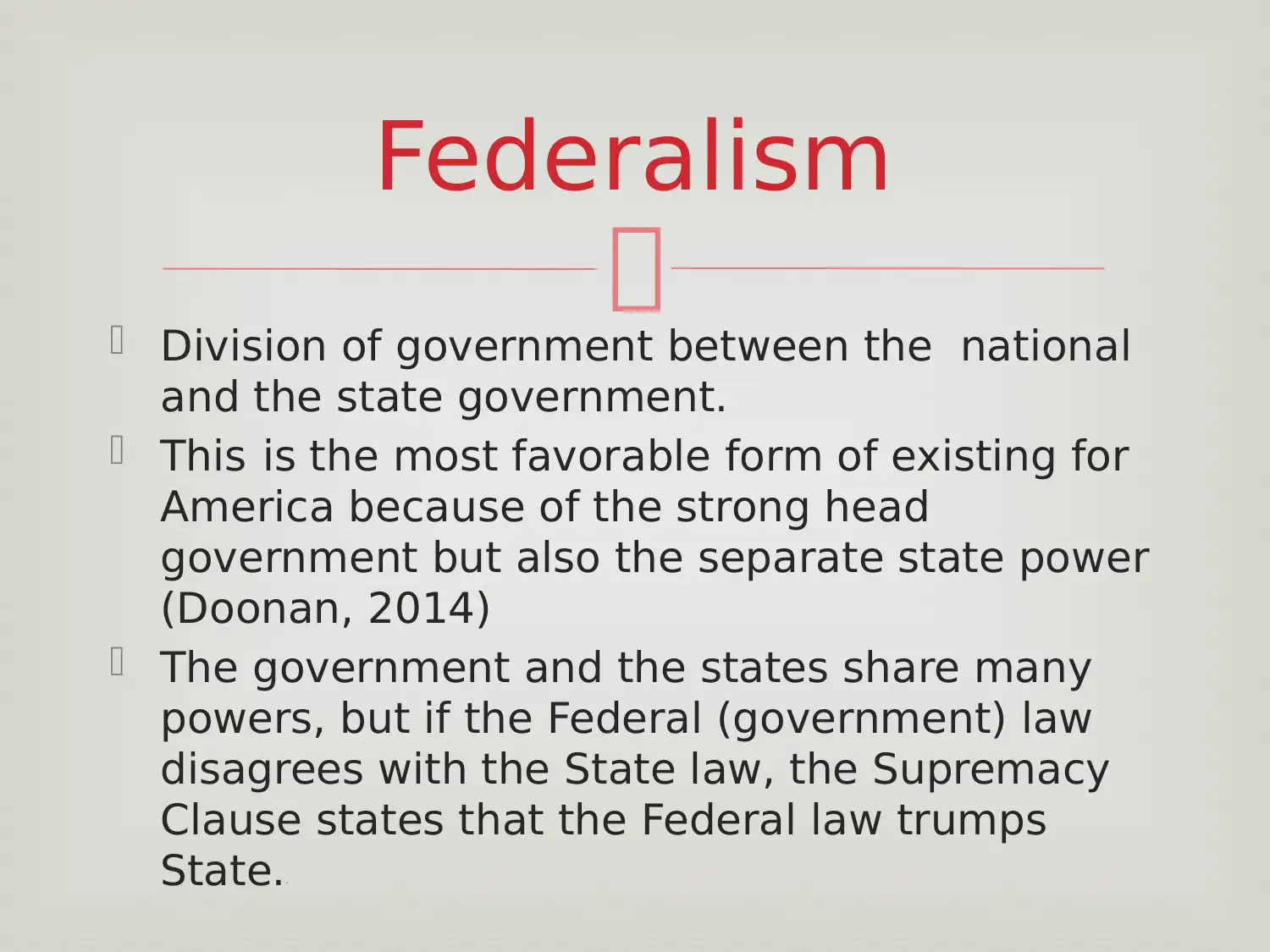
Division of government between the national
and the state government.
This “is the most favorable form of existing for
America because of the strong head
government but also the separate state power
(Doonan, 2014)
The government and the states share many
powers, but if the Federal (government) law
disagrees with the State law, the Supremacy
Clause states that the Federal law trumps
State.”
Federalism
Division of government between the national
and the state government.
This “is the most favorable form of existing for
America because of the strong head
government but also the separate state power
(Doonan, 2014)
The government and the states share many
powers, but if the Federal (government) law
disagrees with the State law, the Supremacy
Clause states that the Federal law trumps
State.”
Federalism
⊘ This is a preview!⊘
Do you want full access?
Subscribe today to unlock all pages.

Trusted by 1+ million students worldwide
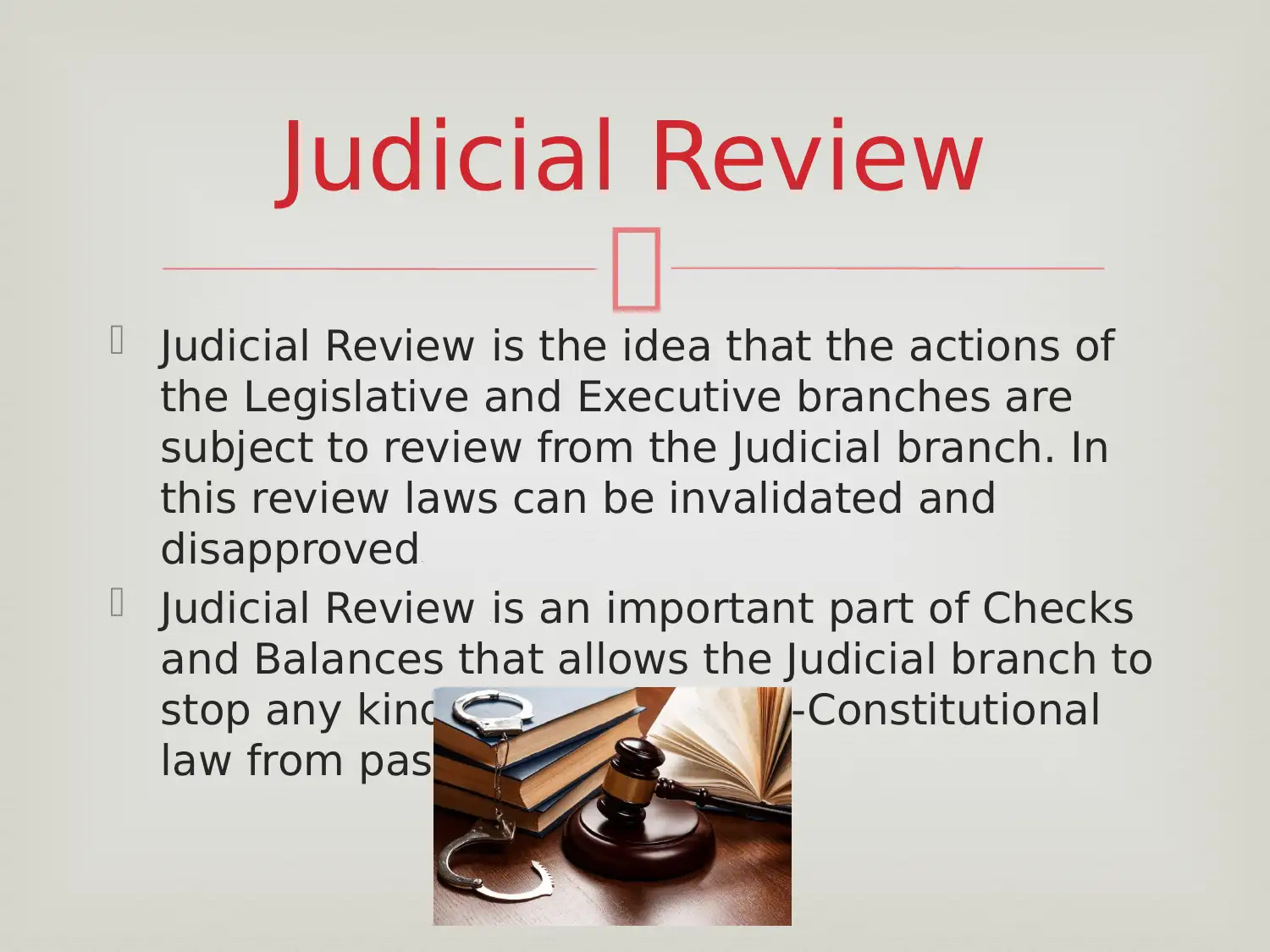
Judicial Review “is the idea that the actions of
the Legislative and Executive branches are
subject to review from the Judicial branch. In
this review laws can be invalidated and
disapproved”.
Judicial Review “is an important part of Checks
and Balances that allows the Judicial branch to
stop any kind of corrupt or un-Constitutional
law from passing.”
Judicial Review
Judicial Review “is the idea that the actions of
the Legislative and Executive branches are
subject to review from the Judicial branch. In
this review laws can be invalidated and
disapproved”.
Judicial Review “is an important part of Checks
and Balances that allows the Judicial branch to
stop any kind of corrupt or un-Constitutional
law from passing.”
Judicial Review
Paraphrase This Document
Need a fresh take? Get an instant paraphrase of this document with our AI Paraphraser
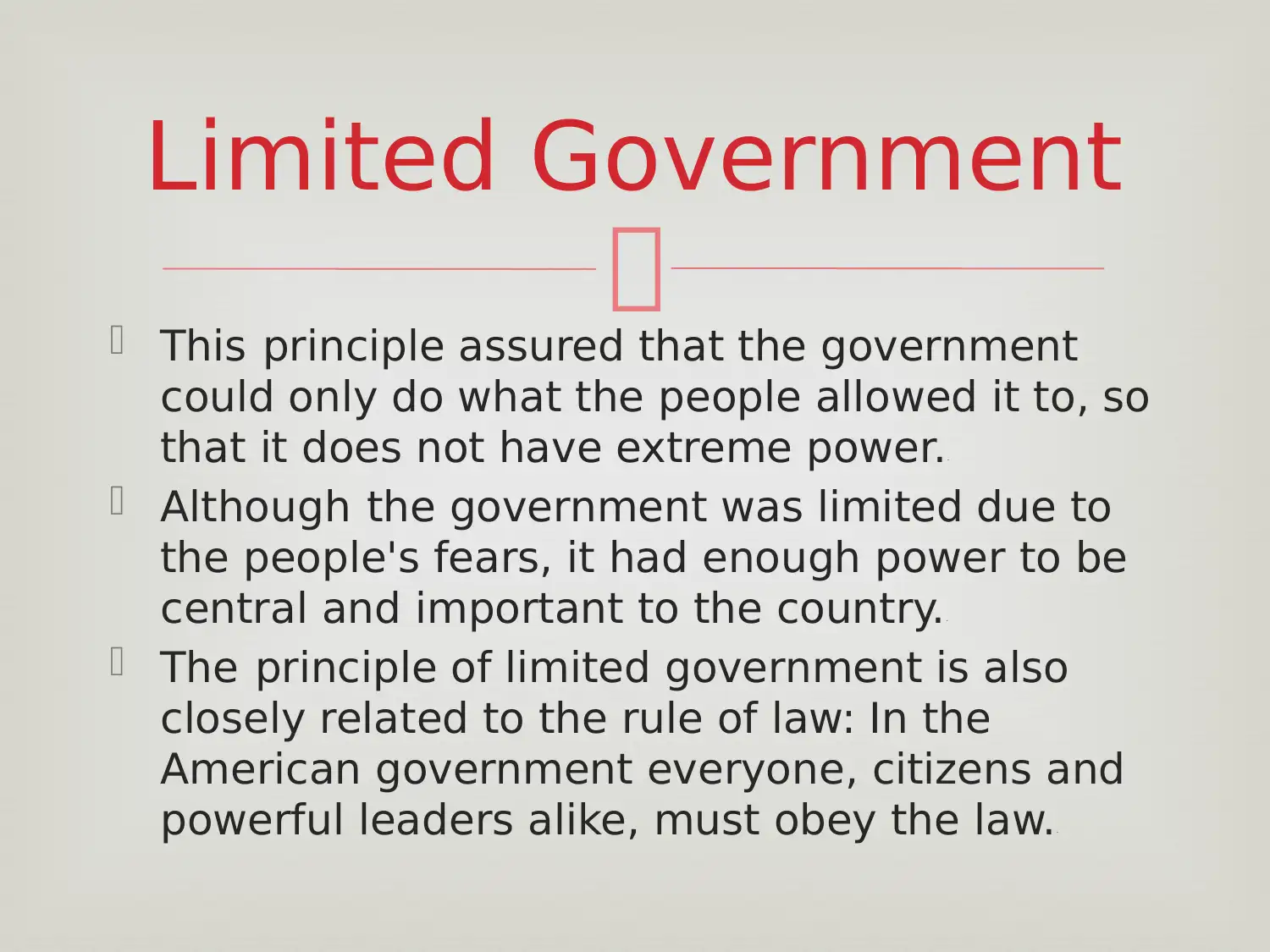
This “principle assured that the government
could only do what the people allowed it to, so
that it does not have extreme power.”
Although “the government was limited due to
the people's fears, it had enough power to be
central and important to the country.”
The “principle of limited government is also
closely related to the rule of law: In the
American government everyone, citizens and
powerful leaders alike, must obey the law.”
Limited Government
This “principle assured that the government
could only do what the people allowed it to, so
that it does not have extreme power.”
Although “the government was limited due to
the people's fears, it had enough power to be
central and important to the country.”
The “principle of limited government is also
closely related to the rule of law: In the
American government everyone, citizens and
powerful leaders alike, must obey the law.”
Limited Government
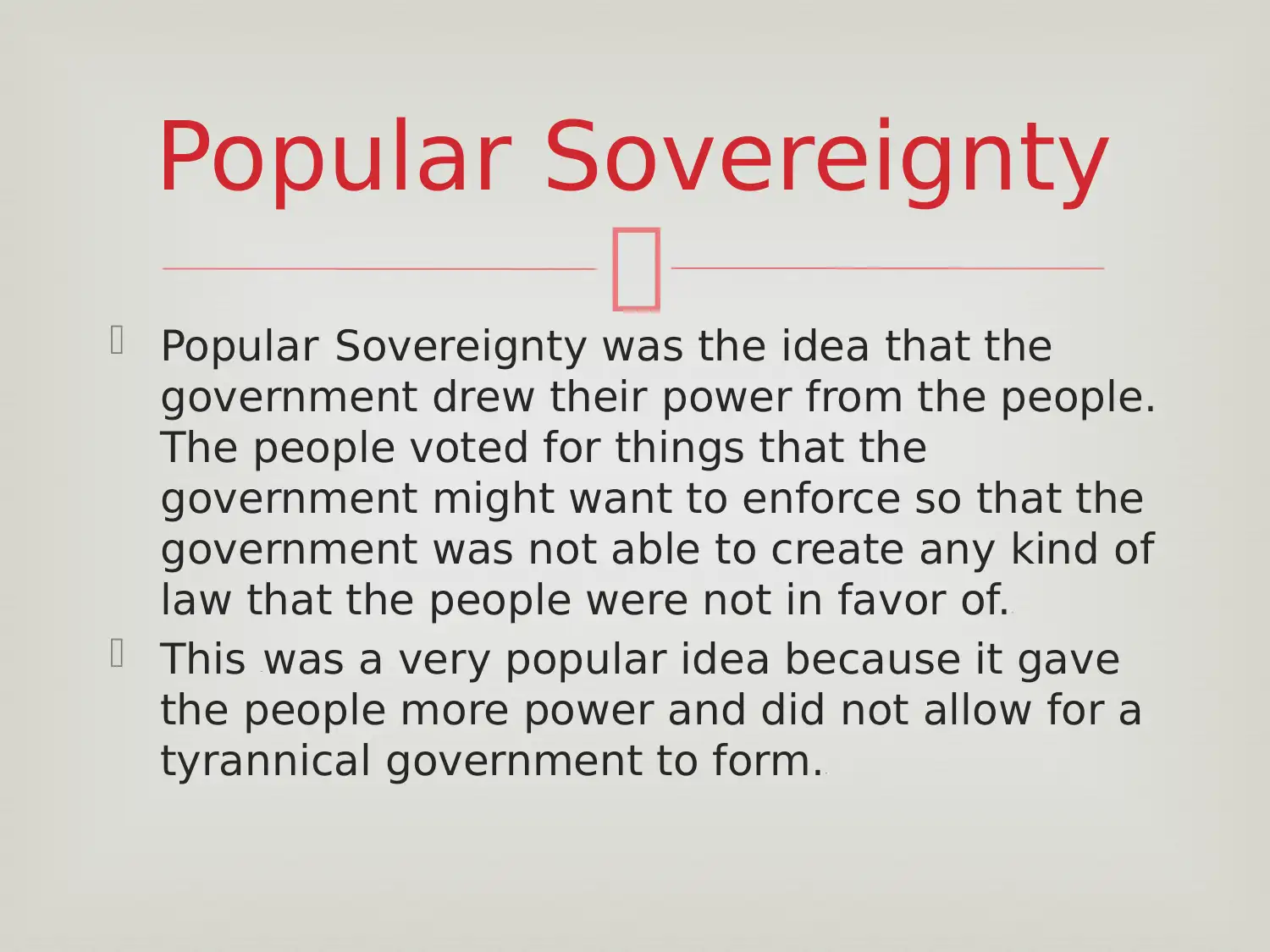
Popular “Sovereignty was the idea that the
government drew their power from the people.
The people voted for things that the
government might want to enforce so that the
government was not able to create any kind of
law that the people were not in favor of.”
This “was a very popular idea because it gave
the people more power and did not allow for a
tyrannical government to form.”
Popular Sovereignty
Popular “Sovereignty was the idea that the
government drew their power from the people.
The people voted for things that the
government might want to enforce so that the
government was not able to create any kind of
law that the people were not in favor of.”
This “was a very popular idea because it gave
the people more power and did not allow for a
tyrannical government to form.”
Popular Sovereignty
⊘ This is a preview!⊘
Do you want full access?
Subscribe today to unlock all pages.

Trusted by 1+ million students worldwide
1 out of 15
Related Documents
Your All-in-One AI-Powered Toolkit for Academic Success.
+13062052269
info@desklib.com
Available 24*7 on WhatsApp / Email
![[object Object]](/_next/static/media/star-bottom.7253800d.svg)
Unlock your academic potential
Copyright © 2020–2025 A2Z Services. All Rights Reserved. Developed and managed by ZUCOL.




